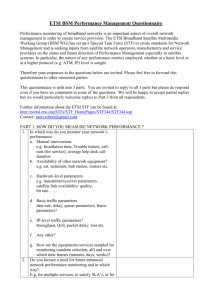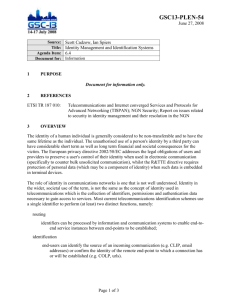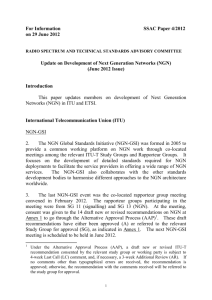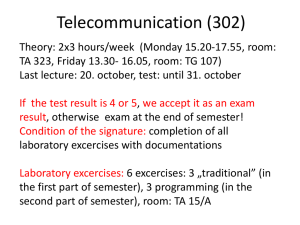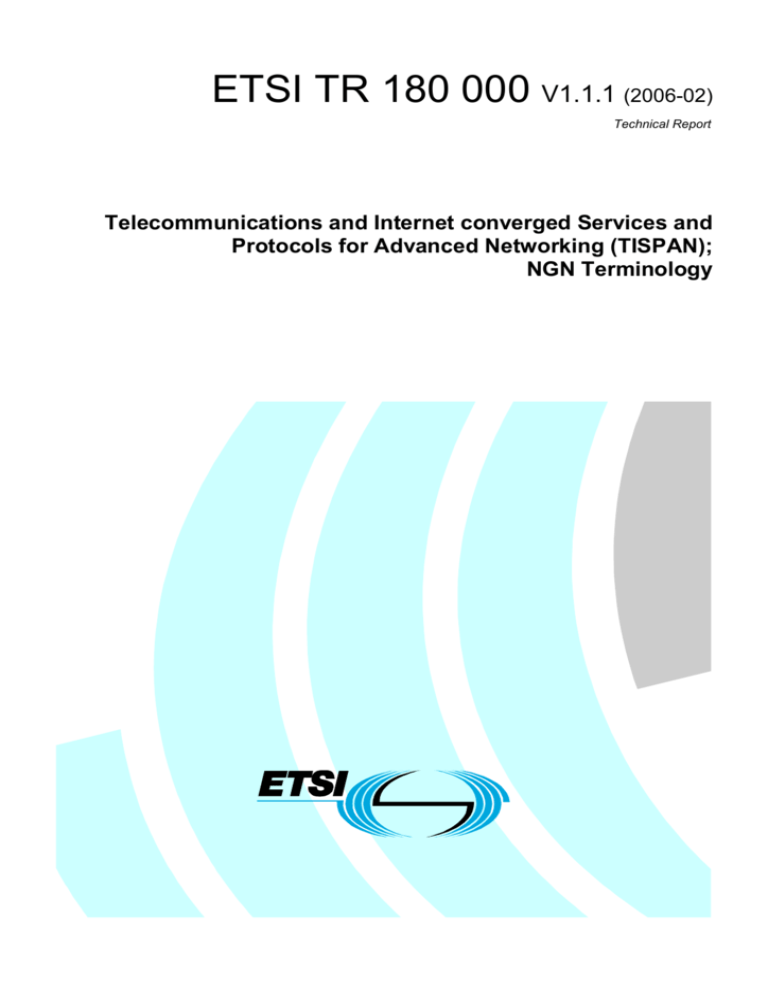
ETSI TR 180 000 V1.1.1 (2006-02)
Technical Report
Telecommunications and Internet converged Services and
Protocols for Advanced Networking (TISPAN);
NGN Terminology
2
ETSI TR 180 000 V1.1.1 (2006-02)
Reference
DTR/TISPAN-00004-NGN
Keywords
vocabulary
ETSI
650 Route des Lucioles
F-06921 Sophia Antipolis Cedex - FRANCE
Tel.: +33 4 92 94 42 00 Fax: +33 4 93 65 47 16
Siret N° 348 623 562 00017 - NAF 742 C
Association à but non lucratif enregistrée à la
Sous-Préfecture de Grasse (06) N° 7803/88
Important notice
Individual copies of the present document can be downloaded from:
http://www.etsi.org
The present document may be made available in more than one electronic version or in print. In any case of existing or
perceived difference in contents between such versions, the reference version is the Portable Document Format (PDF).
In case of dispute, the reference shall be the printing on ETSI printers of the PDF version kept on a specific network drive
within ETSI Secretariat.
Users of the present document should be aware that the document may be subject to revision or change of status.
Information on the current status of this and other ETSI documents is available at
http://portal.etsi.org/tb/status/status.asp
If you find errors in the present document, please send your comment to one of the following services:
http://portal.etsi.org/chaircor/ETSI_support.asp
Copyright Notification
No part may be reproduced except as authorized by written permission.
The copyright and the foregoing restriction extend to reproduction in all media.
© European Telecommunications Standards Institute 2006.
All rights reserved.
DECTTM, PLUGTESTSTM and UMTSTM are Trade Marks of ETSI registered for the benefit of its Members.
TIPHONTM and the TIPHON logo are Trade Marks currently being registered by ETSI for the benefit of its Members.
3GPPTM is a Trade Mark of ETSI registered for the benefit of its Members and of the 3GPP Organizational Partners.
ETSI
3
ETSI TR 180 000 V1.1.1 (2006-02)
Contents
Intellectual Property Rights ................................................................................................................................ 4
Foreword............................................................................................................................................................. 4
Introduction ........................................................................................................................................................ 4
1
Scope ........................................................................................................................................................ 5
2
References ................................................................................................................................................ 5
3
Abbreviations ........................................................................................................................................... 6
4
Definition of NGN ................................................................................................................................... 6
5
Environmental terms ................................................................................................................................ 7
5.1
5.2
6
6.1
7
7.1
7.2
8
8.1
Domains ............................................................................................................................................................. 7
Networks ............................................................................................................................................................ 7
NGN Structure ......................................................................................................................................... 8
NGN components .............................................................................................................................................. 8
Users and Mobility ................................................................................................................................... 9
User related terminology ................................................................................................................................... 9
Mobility ........................................................................................................................................................... 10
NGN Services......................................................................................................................................... 11
Basic terms....................................................................................................................................................... 11
History .............................................................................................................................................................. 12
ETSI
4
ETSI TR 180 000 V1.1.1 (2006-02)
Intellectual Property Rights
IPRs essential or potentially essential to the present document may have been declared to ETSI. The information
pertaining to these essential IPRs, if any, is publicly available for ETSI members and non-members, and can be found
in ETSI SR 000 314: "Intellectual Property Rights (IPRs); Essential, or potentially Essential, IPRs notified to ETSI in
respect of ETSI standards", which is available from the ETSI Secretariat. Latest updates are available on the ETSI Web
server (http://webapp.etsi.org/IPR/home.asp).
Pursuant to the ETSI IPR Policy, no investigation, including IPR searches, has been carried out by ETSI. No guarantee
can be given as to the existence of other IPRs not referenced in ETSI SR 000 314 (or the updates on the ETSI Web
server) which are, or may be, or may become, essential to the present document.
Foreword
This Technical Report (TR) has been produced by ETSI Technical Committee Telecommunications and Internet
converged Services and Protocols for Advanced Networking (TISPAN).
The present document is a collection of NGN terminology for reference by other TISPAN-NGN documents.
Introduction
There is a great diversity in the terminology used for NGNs, when different bodies, different groups within the same
body and even different documents within the same group often follow their own particular usage. The same term may
be used with slightly or even completely different meanings, and different terms may apply to the same object. Also,
terminology with a telecommunications history often has to be adapted to make it suitable to NGN. Thus, it is important
to find a commonly accepted set of fundamental terms within TISPAN before divergence sets in.
Wherever possible, the present document refers to existing terminology from ETSI and ITU-T sources. However,
because the assumptions underlying many of those definitions have changed drasticly, a number of modifications were
necessary. In some cases, new definitions of existing terms had to be introduced. Although this may lead to confusion, it
follows the real situation where many terms have taken on a new meaning.
ETSI
5
1
ETSI TR 180 000 V1.1.1 (2006-02)
Scope
The present document provides a common pool of terminology for use within the TISPAN-NGN project. It is intended
that all NGN documents refer to the present document within their definitions clause for their basic terminology.
If a specific term also used by the 3GPP is not defined in the present document, then the definition in the 3GPP
terminology document [1] shall be valid.
The present document contains both definitions and explanations of terms. Explanatory text is intended as purely
informational material. The definitions are marked as such and follow the structure:
1)
Term to be defined.
2)
Definition text.
3)
Source of definition (optional).
4)
Note(s) (explanatory notes).
5)
Editor's notes.
2
References
For the purposes of this Technical Report (TR) the following references apply:
[1]
NOTE:
ETSI TR 121 905: "Digital cellular telecommunications system (Phase 2+); Universal Mobile
Telecommunications System (UMTS); Vocabulary for 3GPP Specifications (3GPP TR 21.905
version 7.0.0 Release 7)".
Informative references to the sources of particular definitions are given within the text.
[2]
ITU-T Recommendation Y.2001: "General overview of NGN".
[3]
ITU-T Recommendation Y.110: "Global Information Infrastructure principles and framework
architecture".
[4]
ETSI TR 101 878: "Telecommunications and Internet Protocol Harmonization Over Networks
(TIPHON) Release 5; Service Capability Definition; Service Capabilities for a Multi Media Call".
[5]
ITU-T Recommendation X.115: "Definition of address translation capability in public data
networks".
[6]
ETSI TS 102 261: "Open Network Services and Architecture (ONSA); Abstract architecture and
reference points definition; Mapping of functional architectures and requirements for NGN".
[7]
ETSI ES 282 001: "Telecommunications and Internet converged Services and Protocols for
Advanced Networking (TISPAN); NGN Functional Architecture Release 1".
[8]
ITU-T Recommendation M.3050.1: "Enhanced Telecommunications Operations Map - The
business process framework".
[9]
ITU-T Recommendation Q.1761: "Principles and requirements for convergence of fixed and
existing IMT-2000 systems".
[10]
ETSI TS 122 228: "Digital cellular telecommunications system (Phase 2+); Universal Mobile
Telecommunications System (UMTS); Service requirements for the Internet Protocol (IP)
multimedia core network subsystem (IMS); Stage 1".
ETSI
6
3
ETSI TR 180 000 V1.1.1 (2006-02)
Abbreviations
For the purposes of the present document, the following abbreviations apply:
3GPP
ATA
CoIx
CPE
CS
ETSI
IAD
IETF
IP
ISDN
ITU-T
MM
NGN
PES
PS
PSTN
QoS
RGW
SIP
SoIx
SPAN
TE
TIPHON
TISPAN
UE
URI
WLAN
xDSL
4
The 3rd Generation Partnership Project
Analog Terminal Adapter
Connectivity-oriented Interconnection
Customer Premises Equipment
Circuit Switched
European Telecommunications Standards Institute
Integrated Access Device
Internet Engineering Task Force
Internet Protocol
Integrated Services Digital Network
International Telecommunication Union - Telecommunication standardization sector
Mobility Management
Next Generation Network
PSTN/ISDN Emulation Subsystem
Packet Switched
Public Switched Telephone Network
Quality of Service
Residential GateWay
Session Initiation Protocol
Service-oriented Interconnection
Services and Protocols for Advanced Networks
Terminal Equipment
Telecommunications and Internet Protocol Harmonisation Over Networks
Telecommunications and Internet converged Services and Protocols for Advanced Networking
User Equipment
Uniform Resource Identifier
Wireless Local Area Network
x-Digital Subscriber Line
Definition of NGN
Next Generation Network, NGN:
A Next Generation Network is a packet-based network able to provide services including Telecommunication Services
and able to make use of multiple broadband, QoS-enabled transport technologies and in which service-related functions
are independent from underlying transport-related technologies. It offers unrestricted access by users to different service
providers. It supports generalized mobility which will allow consistent and ubiquitous provision of services to users.
The NGN is characterized by the following fundamental aspects:
Packet-based transfer.
Separation of control functions among bearer capabilities, call/session, and application/service.
Decoupling of service provision from network, and provision of open interfaces.
Support for a wide range of services, applications and mechanisms based on service building blocks (including
real time/ streaming/ non-real time and multi-media services).
Broadband capabilities with end-to-end QoS and transparency.
Interworking with legacy networks via open interfaces.
Mobility.
Unrestricted access by users to different service providers.
ETSI
7
ETSI TR 180 000 V1.1.1 (2006-02)
A variety of identification schemes which can be resolved to IP addresses for the purposes of routing in IP
networks.
Unified service characteristics for the same service as perceived by the user.
Converged services between Fixed/Mobile.
Independence of service-related functions from underlying transport technologies.
Compliant with all Regulatory requirements, for example concerning emergency communications and
security/privacy, lawful interception etc.
Support of multiple last mile technologies.
Source: Based on ITU-T Recommendation Y.2001 [2].
5
Environmental terms
This clause contains terms which describe the environment in which an NGN operates.
5.1
Domains
Domains describe the infrastructure owned by single operators.
(General) domain: A collection of physical or functional entities which are owned and operated by a player and can
include entities from more than one role. The extent of a domain is defined by a useful context and one player can have
more than one domain.
Source: Based on ITU-T Recommendation Y.110 [3].
NOTE:
Usage of the term domain in association with URIs follows the IETF related definition and usage of the
term domain in association with CS and PS follows the 3GPP related definition.
Administrative domain: A collection of physical or functional entities under the control of a single administration.
Source: TR 101 878 [4] and TS 102 261 [6]; very similar to definition in ITU-T Recommendation X.115 [5].
User domain: A collection of physical or functional entities under the control of an end-user that share a consistent set
of policies and common technologies.
Source: TR 101 878 [4] and TS 102 261 [6].
Service domain: A collection of physical or functional entities offering IP based services under the control of an NGN
Service Provider which share a consistent set of policies and common technologies.
Source: Based on TR 101 878 [4] and TS 102 261 [6].
5.2
Networks
The terms listed here describe the connectivity infrastructure surrounding an NGN.
Core network: A portion of the delivery system composed of networks, systems equipment and infrastructures,
connecting the service providers to the access network. The core network is independent of the connection technology
of the terminal (e.g. radio, WLAN, xDSL, …)
Source: ES 282 001 [7].
ETSI
8
ETSI TR 180 000 V1.1.1 (2006-02)
Core Transport Network: A collection of entities that provides IP transport connectivity between an Access Network
and another Core Transport Network, between an Access Network and another Access Network, and connectivity to
Service Layer entities. Core Transport Networks are distinguished from one another based on the underlying
technology, ownership and/or administrative partitioning. Core Transport Networks do not directly connect to User
Domains.
Source: Based on ITU-T NGN Focus Group.
Access network: The collection of network entities and interfaces that provides the underlying IP transport connectivity
between the device and the NGN entities.
Source: ES 282 001 [7].
Service-oriented Interconnection (SoIx): The physical and logical linking of NGN domains that allows carriers and
service providers to offer services over NGN (i.e. IMS and PES) platforms with control, signalling (i.e. session-based),
which provides defined levels of interoperability.
Source: TISPAN WG1.
NOTE:
For instance, this is the case of "carrier grade" voice end/or multimedia services over IP interconnection.
"Defined levels of interoperability" are dependent upon the service or the QoS or the Security, etc.
Connectivity-oriented Interconnection (CoIx): The physical and logical linking of carriers and service providers
based on simple IP connectivity irrespective of the levels of interoperability.
Source: TISPAN WG1.
NOTE:
For example, an IP interconnection of this type is not aware of the specific end-to-end service and, as a
consequence, service-specific network performance, QoS and security requirements are not necessarily
assured. This definition does not exclude that some services may provide a defined level of
interoperability. However only SoIx fully satisfies NGN interoperability requirements.
6
NGN Structure
6.1
NGN components
PSTN/ISDN Emulation: Provides PSTN/ISDN service capabilities and interfaces using adaptation to an IP
infrastructure.
Source: TISPAN WG 2.
PSTN/ISDN Simulation: Provides PSTN/ISDN-like service capabilities using session control over IP interfaces and
infrastructure.
Source: TISPAN WG 2.
NOTE 1: Not all service capabilities and interfaces have to be present to provide an emulation.
NOTE 2: Those are definitions of the terms or concepts "simulation" and "emulation", not a definition of the
architectural entities used to realize them. The architectural entity "emulation subsystem" is a
consequence of the requirements posed on it, and it is called "emulation subsystem" because those
requirements fit the above definition.
NOTE 3: This definition allows for the possibility of simulation providing a complete mapping of the PSTN / ISDN
service set (complete simulation).
ETSI
9
7
Users and Mobility
7.1
User related terminology
ETSI TR 180 000 V1.1.1 (2006-02)
User, End user: The user is the actual user of the products or services offered by the Enterprise. The user consumes the
product or service.
Source: ITU-T Recommendation M.3050.1 [8].
NOTE:
Enterprise is defined in ITU-T Recommendation M.3050.1 [8].
Subscriber: The person or organization responsible for concluding contracts for the services subscribed to and for
paying for these services.
Source: ITU-T Recommendation M.3050.1 [8].
NOTE:
See also definition of customer.
Subscription: A subscription describes the commercial relationship between the subscriber and the service provider.
Source: TR 121 905 [1].
Customer: The customer buys products and services from the Enterprise or receives free offers or services. A
Customer may be a person or a business.
Source: ITU-T Recommendation M.3050.1 [8].
NOTE:
Enterprise is defined in ITU-T Recommendation M.3050.1 [8].
User Equipment (UE): One or more devices allowing user access to network services delivered by TISPAN NGN
networks.
Source: ES 282 001 [7].
NOTE 1: This includes devices under user control commonly referred to as CPE, IAD, ATA, RGW, TE, etc., but
not network controlled entities such as access gateways.
NOTE 2: This definition differs from that provided in [1].
NOTE 3: User Equipment is sometimes referred to as Customer Equipment (customer ownership of the UE).
Originating Party: User who initiates a communication.
Terminating Party: User who receives an incoming communication request.
User Profile: The set of information necessary to provide a user with a consistent, personalised service environment,
irrespective of the user's location or the terminal used (within the limitations of the terminal and the serving network).
Source: TR 121 905 [1].
Identity: The attributes by which an entity or person is described, recognized or known.
Source: ITU-T NGN Focus Group.
ETSI
10
7.2
ETSI TR 180 000 V1.1.1 (2006-02)
Mobility
Figure 1 provides a decomposition picture of mobility into component parts.
Mobility
Service
Continuity
Seamless
Handover
Service
Discontinuity
Handover
Roaming
Portability
Figure 1: Representation of some relevant terms in the Mobility domain
Mobility:The ability for the user or other mobile entities to communicate and access services irrespective of changes of
the location or technical environment. The degree of service availability may depend on several factors including the
Access Network capabilities, service level agreements between the user's home network and the visited network (if
applicable), etc. Mobility includes the ability of telecommunication with or without service continuity.
Source: ITU-T Recommendation Y.2001 [2].
NOTE:
In ITU-T Recommendation Y.2001 [2] this is called Generalized Mobility.
Service continuity: The ability for a user to maintain an ongoing service during mobility.
Source: ITU-T NGN Focus Group.
Mobility with Service discontinuity: An alternative term for Nomadism.
Nomadism: Ability of the user to change his network access point; when changing the network access point, the user's
service session is completely stopped and then started again, i.e., there is no session continuity or hand-over possible. It
is assumed that normal usage pattern is that users shutdown their service session before changing to another access
point.
Source: Based on ITU-T Recommendation Q.1761 [9].
Seamless handover: A special case of mobility with service continuity, when the provision of services is preserved
without any perceived impact on current communications during movement.
Handover: A case of mobility with service continuity, when the provision of services is preserved during movement,
but an impact on current communications may result in perception by the user (e.g. a short interruption in media
exchange).
Roaming: The ability of users to access services while outside of their subscribed home network, i.e. by using an
access point of a visited network. This is usually supported by a roaming agreement between the respective network
operators.
NOTE:
The roaming definition above implies mobility with service discontinuity as indicated in figure 1.
Portability, terminal portability: A restrictive case of mobility with service discontinuity that requires an indication of
disassociation from one access point, movement to another location, and association or connection to another access
point. E.g. the disconnection from one network operator and roaming to a visted network for a new connection, that
often involves a "power down" and start up sequence.
Home Network: The network associated with the operator/service provider that owns the subscription of the customer.
Source: Based on ITU-T NGN Focus Group.
Visited Network: The network that is local to the customer in a roaming scenario.
Source: Based on ITU-T NGN Focus Group.
ETSI
11
ETSI TR 180 000 V1.1.1 (2006-02)
Personal mobility: This is the mobility for those scenarios where the user changes the terminal used for network access
at different locations. The ability of a user to access telecommunication services at any terminal on the basis of a
personal identifier, and the capability of the network to provide those services delineated in the user's service profile.
Source: ITU-T NGN Focus Group.
NOTE:
Personal mobility is sometimes referred to as User mobility. User mobility is defined as the user having
the capability to be able to move to different physical locations and use a terminal. In today's world there
are examples of this already implemented. For example a user can travel around the world and use the
public fixed line telephone network to be able to receive either all of the services that they would receive
from their home fixed line telephone, or a limited number of services. Primarily the minimum service is
the ability to make a voice call. Likewise a user can connect to their email by making use of internet cafes
etc. The similarity of both cases is that the user is being provided with a terminal/device to gain access to
there service. As for identification, the user has no unique identity in terms of the access network.
Terminal Mobility: This is mobility for those scenarios where the same terminal equipment is moving or is used at
different locations. The ability of a terminal to access telecommunication services from different locations or while in
motion, and the capability of the network to identify and locate that terminal.
Source: ITU-T NGN Focus Group.
NOTE:
Terminal Mobility is an extension of User Mobility, although it is possible to have Terminal Mobility
without User Mobility. Terminal Mobility is defined as the terminal having the ability to be moved to
different physical locations and provide the user access to their services by one or more different access
methods.
8
NGN Services
8.1
Basic terms
Service capability: Specified function (or group of functions) that is used either alone or in combination with other
service capabilities to realize a complete service. These are within networks and under network control. Service
capabilities may be provided either by the network operator or by 3rd parties via appropriate interfaces.
Source: Based on TR 101 878 [4] merged with ITU-T NGN Focus Group.
IP multimedia application: An application that handles one or more media simultaneously such as audio, video and
data (e.g. chat, shared whiteboard) in a synchronised way from the user's point of view. A multimedia application may
involve multiple parties, multiple connections, and the addition or deletion of resources within a single IP multimedia
session. A user may invoke concurrent IP multimedia applications in an IP multimedia session.
Source: TS 122 228 [10].
NOTE :
An IP multimedia application need not necessarily be part of an IP multimedia session since in
TISPAN_NGN multimedia applications can be provided by many different subsystems (e.g. streaming
subsystem, IP Multimedia sub-system etc).
IP multimedia service: An IP multimedia service is the user experience provided by one or more IP multimedia
applications.
Source: TS 122 228 [10].
Session, IP multimedia session: An IP multimedia session is a set of multimedia senders and receivers and the data
streams flowing from senders to receivers. IP multimedia sessions are supported by the NGN and are enabled by IP
connectivity bearers. A user may invoke concurrent IP multimedia sessions.
Source: TS 122 228 [10].
ETSI
12
History
Document history
V1.1.1
February 2006
Publication
ETSI
ETSI TR 180 000 V1.1.1 (2006-02)


